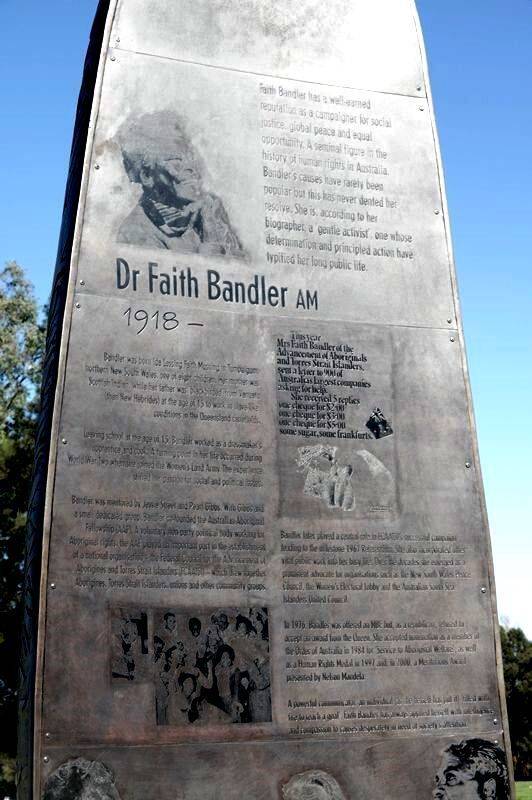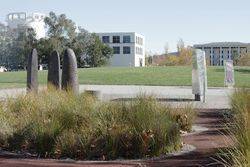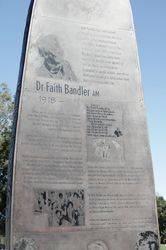
Home » Themes » People » Indigenous
Faith BandlerPrint Page 
The artwork commemorates political activist and writer, Dr. Faith Bandler, A.M. (1918 - 2015) and recognises her contribution to Reconciliation in Australia.
Three cast bronze slivers create the focus of the Women Artwork. The concave etched copper surface of each sliver presents a biographical sketch of Dr Faith Bandler, Lady Jessie Street and Dr Evelyn Scott. The artwork serves to remind us of the determination of these women and their collective contribution to Reconciliation in Australia, including through their roles in the 1967 Referendum.
The slivers are arranged to form a contemplative space adjacent to a circular seat, which incorporates an audio feature comprising personal reflections by Dr Faith Bandler, Dr Evelyn Scott and Sir Laurence Street. Two key words and a quotation feature on the convex side of each sliver, highlighting personal values or qualities particular to each individual. Incorporated into the surrounding pavement are additional words embodying qualities and values considered mutually important to all three women.
The artwork patterning was designed by Jenuarrie, who shares with Faith Bandler a Pacific Islander heritage.
Dr. Bandler was born in Tumbulgum, New South Wales, and named Ida Lessing Mussing, the second child in a family of eight. Her father, Wacvie Peter Mussing from Biap village, Ambrym, in Vanuatu, had been taken to Australia in 1883 when he was 12. Her mother was Scottish-Indian, born in Brisbane.
Educated at Murwillumbah and Cleveland Street Night School in Sydney, Faith married Hans Bandler in 1952, and became involved in indigenous politics as co-founder of the Aboriginal-Australian Fellowship in 1956. One of the crucial leaders of the 1967 referendum campaign to enable the Commonwealth government to legislate on behalf of indigenous Australians and to include them in the national census, Dr Bandler was also General Secretary of the Federal Council for the Advancement of Aborigines and Torres Strait Islanders (1970–73). In 1976 she was awarded an MBE but refused to accept it.
While maintaining her interest in indigenous affairs, as Director of the Co-operative for Aborigines and Islanders in the 1970s, and in women’s issues, since the mid 1970s Bandler has turned her talents to obtaining recognition and special benefits for the descendants of her father’s people, Australia’s South Sea islanders, brought to Queensland as indentured labourers, between 1863 and 1904.
Most of the islanders were repatriated under 1901 Commonwealth White Australia legislation, but some 2000 remained, who had intermarried mainly with indigenous Australians. Instrumental in the formation of the Australian South Sea Islanders United Council in 1974, Bandler helped lobby the Australian government. In 1991 at her urging, the Evatt Foundation commissioned a survey of the islanders, which led to a wider government investigation by the Human Rights and Equal Opportunity Commission, published as The Call for Recognition. The final result was the 1994 announcement of a package of grants, programs and special funding for Australia’s South Sea islander community.
Location
| Address: | King Edward Terrace, Reconciliation Place, Parkes, 2600 |
|---|---|
| State: | ACT |
| Area: | AUS |
| GPS Coordinates: | Lat: -35.298993 Long: 149.133662 Note: GPS Coordinates are approximate. |
Details
| Monument Type: | Art |
|---|---|
| Monument Theme: | People |
| Sub-Theme: | Indigenous |
| Designer: | Sliver -Belinda Smith, Rob Tindal (artists), Jennifer Marchant (graphic designer), Artwork Patterning- Jenuarrie |








